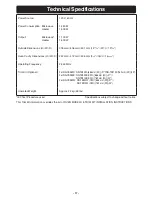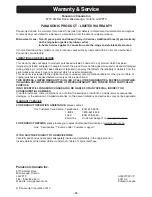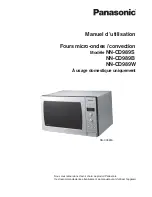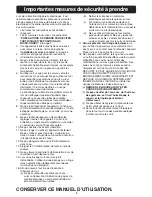
- 6 -
Safety Precaution
Utensils
1. Microwave browning dishes or grills are designed
for microwave cooking only.
DO NOT
use on browning cycle or on rack.
Preheating times vary depending on the size of
the browning dish and food being cooked. Always
follow instructions provided by the browning dish
or grill manufacturer.
DO NOT
PREHEAT THE
BROWNING DISH FOR MORE THAN
6 MINUTES in the microwave.
2. Metal containers or dishes with metallic trim
should not be used during Microwave or
Combination cooking. Arcing may occur.
3. Metal twist-ties should not be used for Microwave
or Combination cooking, Arcing will occur.
4.
DO NOT
use sealed jars or narrow neck bottles
for cooking or reheating. They may shatter.
5.
DO NOT
use conventional thermometers for
Microwave or Combination cooking. They may
cause arcing.
DO NOT
use a Microwave meat
thermometer for Combination cooking or Bake
cooking. It may melt.
6. Remove plastic wraps, before cooking or
defrosting in the oven.
7. If an oven cooking bag is used, prepare
according to the package directions.
DO NOT
use a wire twist-tie to close bag.
Instead, use a plastic tie, a piece of cotton string
or a strip cut from the open end of the bag. Make
six 1.5 cm (
1
⁄
2
") slits by the closure. Place oven
cooking bag in a dish slightly larger than the food
being cooked.
8. When using foil, skewers, racks or utensils made
of metal in the oven for Microwave or
Combination cooking, allow at least 2.5 cm (1")
of space between the metal material and interior
oven walls. If arcing occurs, remove the metal
material (skewers, etc.) and/or transfer to a
nonmetallic container.
DO NOT
use with rack.
9.
DO NOT
use paper bags or recycled paper
products in the microwave oven.
10.
DO NOT
use paper towels or cloths which
contain a synthetic fiber woven into them, such
as nylon. The synthetic fiber may cause the towel
or cloth to ignite. Use paper towels with caution.
11. The oven door and interior walls will get hot
during cooking.
12. Cooking containers get hot during cooking. Use
pot holders when removing containers from the
oven or when removing lids or plastic wrap
covers from cooking utensils, to avoid burns.
13. The Ceramic Tray will get hot during cooking.
It should be allowed to cool before handling or
before using paper products, such as paper
plates, napkins or microwave cooking.
14. Utensils for Combination setting, should be heat-
safe, microwaveable dishes.
Food
1.
DO NOT use your oven for home canning
or
the heating of any closed jar. Pressure will build
up and the jar may explode. In addition, the
microwave oven cannot maintain the food at the
proper canning temperature. Improperly canned
food may spoil and be dangerous to consume.
2. Small quantities of food or foods with low
moisture content can dry out, burn or catch on
fire when overheated. If a fire occurs, turn the
oven off and leave the oven door closed.
Disconnect the power cord or shut off the power
at the fuse or circuit breaker panel.
3. Popcorn can be popped in a suitable,
microwaveable corn popper using the
manufacturer’s directions or prepackaged bags of
Microwave popcorn can be used with the preset
“Popcorn”
Button program. Always follow the
package directions.
4.
DO NOT
attempt to deep fry in your oven.
Temperature cannot be controlled and fat will
erupt. Many microwave utensils cannot withstand
the temperatures of heated oil, resulting in
shattering or melting.
5.
DO NOT
cook or reheat whole eggs in a
microwave oven. Pressure will build up and the
eggs will explode. Reheating Sliced hard-boiled
eggs and cooking scrambled eggs are safe.
6. Potatoes, apples, chicken wing, whole squash
and sausages are examples of foods with
nonporous skins. This type of food must be
pierced before cooking, to prevent bursting.
7. Use fresh potatoes, and cook until just done. The
potatoes will still feel soft to the touch, but firm
when pierced with a fork. Overcooking causes
dehydration and may cause a fire.
8. Heated liquids can erupt if not mixed with air.
DO NOT
heat liquids in your microwave oven
without first stirring. Over-heated liquids will
erupt.
9. Heat only 1 frozen dinner or entree in the oven at
a time. If the dinner or entree is heated in a foil
tray, leave at least 2.5 cm (1") of space between
the foil tray and the oven walls.
10. Drying meats, fruits, vegetables and herbs is not
recommended.
11.
DO NOT
use the oven for any reason other than
the preparation of food.
12.
DO NOT
leave the oven unattended when in use.







































